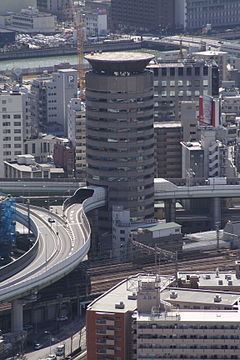Type Office building Completed 1992 Floors 16 Floor area 7,956 m² | Country Japan Height 72 m Opened 1992 Structural system Reinforced concrete | |
 | ||
Client Suezawa Sangyō Co. Ltd. Floor count 16 above ground, 2 underground, 1 elevator equipment tower floor Similar Fukushima Station, Umeda Sky Building, Shin‑Fukushima Station, Broken Chair, Rinku Gate Tower Building | ||
Hanshin expressway going through gate tower building
Gate Tower Building (ゲートタワービル, gēto tawā biru) is a 16 floor office building in Fukushima-ku, Osaka, Japan. It is notable for the highway offramp at Umeda Exit that passes through the building.
Contents
- Hanshin expressway going through gate tower building
- Map of Japan E38092553 0003 C58Csaka fu C58Csaka shi Fukushima ku Fukushima 5 ChomeE288924 EFBCB4EFBCABEFBCB0E382B2E383BCE38388E382BFE383AFE383BCE38393E383AB
- Gate tower building with a highway through it japan
- Overview
- History
- Profile
- References
Map of Japan, %E3%80%92553-0003 %C5%8Csaka-fu, %C5%8Csaka-shi, Fukushima-ku, Fukushima, 5 Chome%E2%88%924, %EF%BC%B4%EF%BC%AB%EF%BC%B0%E3%82%B2%E3%83%BC%E3%83%88%E3%82%BF%E3%83%AF%E3%83%BC%E3%83%93%E3%83%AB
Gate tower building with a highway through it japan
Overview
The building has a double core construction, with a circular cross section. The Umeda Exit of the Ikeda Route of the Hanshin Expressway system (when exiting the highway from the direction of Ikeda) passes between the fifth through seventh floors of this building. The highway is the tenant of those floors. The elevator passes through the floors without stopping: floor 4 being followed by floor 8. The floors through which the highway passes consist of elevators, stairways and machinery. The highway does not make contact with the building. It passes through as a bridge, held up by supports next to the building. The highway is surrounded by a structure to protect the building from noise and vibration. The roof has a helipad.
History
A wood and charcoal business held the property rights for this plot of land since the early Meiji period, but the gradual move to other sources of fuel resulted in the deterioration of those company buildings. In 1983, redevelopment of the area was approved, but building permits were refused because the highway was already being planned. The property rights' holders refused to give up, and negotiated with the Hanshin Expressway corporation for approximately five years to reach the current solution.
Although normally highway corporations purchase the land they build a highway on or over, it is not guaranteed to succeed and therefore issues like this can arise. For that reason, the highway laws, city planning laws, city redevelopment laws and building codes were partly revised in 1989 to allow the unified development of highways and buildings in the same space. This system was originally designed to facilitate the construction of the second Ring Road in the vicinity of Toranomon, Minato-ku, Tokyo, but in the end was not applied there. Instead, the system was put into effect in the construction of the Gate Tower Building, becoming Japan's first building to have a highway pass through it. Normally, highways are still built underground in these cases, and passing through a building is an extremely rare occurrence.
